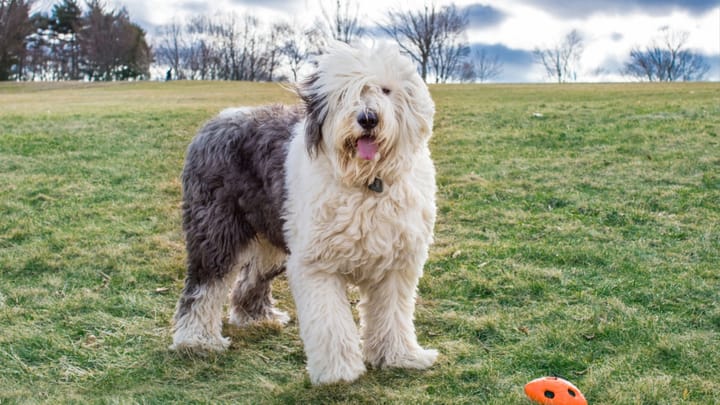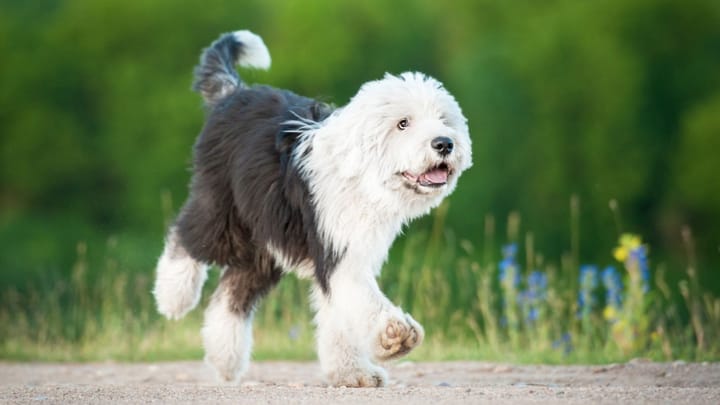Old English Sheepdog
Other name: Bobtail


A herder at heart, the Old English Sheepdog may try to herd their family members like sheep, always trying to gather everyone together. Today, this dog is mainly kept as a pet. They are very sweet and friendly, but not always docile, therefore needing an expert hand. A good guard dog but never aggressive, they are also a wonderful companion for children of all ages.
|
Life expectancy |
The Old English Sheepdog has a life expectancy of between 10 and 12 years |
|
Temperament |
|
|
Size |
Large
|
|
Adult size |
Female
Between 22 and 24 in
Male
Between 24 and 26 in
|
|
Adult weight |
Female
Between 77 and 88 lb
Male
Between 77 and 88 lb
|
|
Coat colour
The head, neck, forelimbs and belly areas are white (with or without marks) and the rest is grey, ranging from all shades of grey or blue. |
White |
|
Type of coat
The coat is long. Very thick, the hair isn’t straight but should in no case be curly; it must be shaggy (scruffy). They have a dense undercoat. |
Long |
|
Eye colour
The eyes are usually dark brown or parti-coloured. Blue eyes are accepted but not sought after. |
Brown
Odd-eyed
|
|
Purchase price |
The Old English Sheepdog costs between £890 and £1100 |
In English, “Bobtail” means shortened tail because of the English Shepherd’s choice to cut their tails during the puppy’s first few days. Some say that English shepherds practiced this to escape the “luxury tax” that concerned pet dog owners: the cut tail was therefore a sign that the dogs were not going on display and were not domestic. Others prefer the hygienic assumption that cutting the tail prevents it from becoming too dirty.
More details about the Old English Sheepdog
Old English Sheepdog: Origins and history
They are a breed with ancient origins: they most probably come from the same old Asian Sheepdog that gave birth to the Berger de la Brie (Briard) in France, the Shepherd of Bergamo in Italy and the Komondor in Hungary. The Bobtail was selected for the first time at the time of the Hundred Years War and the Briard is undoubtedly part of their genealogy.
Physical characteristics of the Old English Sheepdog
The Old English Sheepdog is a large, strong and compact breed, with a square-shaped torso and thick hair all over their stocky, muscular body. The head has a broad and rather square skull, bulging at the forehead. The stop is well-defined, and the muzzle is strong and square, the length being half of that of the whole head. Their small ears are set on either side of the head. Their limbs are straight and perpendicular to the body. Sometimes, the tail is amputated naturally; otherwise, it’s covered by thick, fringed hair.
FCI classification of the Old English Sheepdog
-
Group 1 - Sheepdogs and Cattledogs (except Swiss Cattledogs)
-
Section 1 : Sheepdogs
Old English Sheepdog: Characteristics
Old English Sheepdog: Behaviour
Training a Old English Sheepdog
Considered as not a very docile breed, the Old English Sheepdog’s training can be complicated if it hasn’t started as soon as the puppy arrived home and if the owner’s attitude isn’t firm and consistent. Walks on a lead and socialisation are the key points to work on with this sometimes overly enthusiastic dog.
Old English Sheepdog: Lifestyle
Breed compatibility Old English Sheepdog
Old English Sheepdog: Purchase price
The price of an Old English Sheepdog varies according to origin, age and sex. A pedigree can cost up to £890 and the best bloodlines can be sold for up to £1,100.
Regarding the average budget needed to meet the needs of a dog this size, it costs around £43 a month.
Old English Sheepdog: Shedding
Average
Hair loss is moderate and intensifies naturally during Spring and Autumn during annual moulting periods. Brushing must be more frequent to ensure the beauty and protective qualities of their majestic coat.
Old English Sheepdog: Grooming
This dog’s long coat requires daily care to avoid knots from forming. Daily brushing and disentangling are required. Show dogs can be presented “natural” or can be groomed through a long, complex “crimping” process that makes them much more valuable. This is now the most followed practice and uncrimped Sheepdogs may not be as highly regarded than others (unless the judge is very experienced and can still “see” the dog).
Old English Sheepdog: Health
The life expectancy of this dog is estimated at around 11 years.
This dog is hardy, they usually enjoy a very excellent health.
Although their fur is quite thick, it protects them from both the cold and the heat. However, owners must pay close attention to enthusiastic and active dogs because they can unfortunately go to the end of their limits without stopping.
The Old English Sheepdog’s felted undercoat gives them a very good waterproof quality and therefore protection against bad weather.
The Old English Sheepdog is such an active dog that it’s very rare to come across overweight dogs. If this is the case, it will be the result of a lack of outings and daily exercise.
- Coxo-femoral dysplasia
- Primary ciliary dyskinesia (lung disease)
- Flipped stomach





